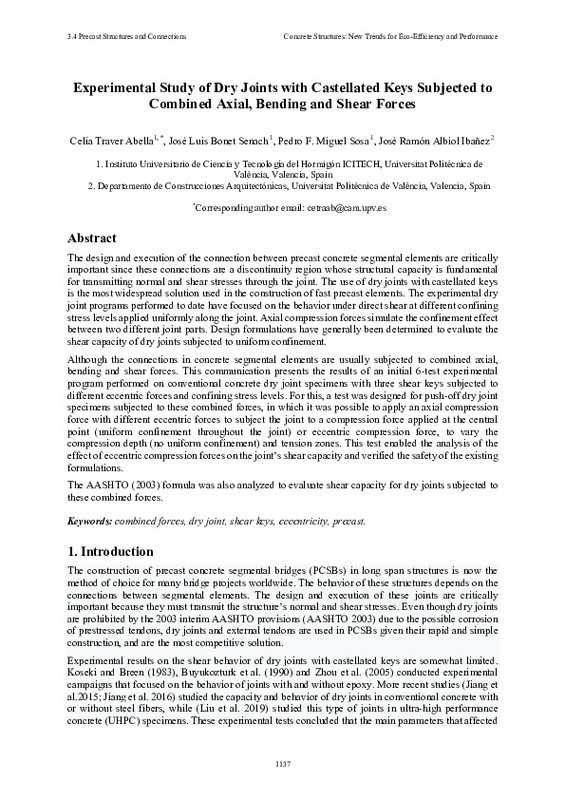JavaScript is disabled for your browser. Some features of this site may not work without it.
Buscar en RiuNet
Listar
Mi cuenta
Estadísticas
Ayuda RiuNet
Admin. UPV
Experimental Study of Dry Joints with Castellated Keys Subjected to Combined Axial, Bending and Shear Forces
Mostrar el registro sencillo del ítem
Ficheros en el ítem
| dc.contributor.author | Traver-Abella, Celia
|
es_ES |
| dc.contributor.author | Bonet Senach, José Luís
|
es_ES |
| dc.contributor.author | Miguel Sosa, Pedro
|
es_ES |
| dc.contributor.author | Albiol Ibáñez, José Ramón
|
es_ES |
| dc.date.accessioned | 2023-01-17T07:26:29Z | |
| dc.date.available | 2023-01-17T07:26:29Z | |
| dc.date.issued | 2021-06-16 | es_ES |
| dc.identifier.isbn | 978-2-940643-08-0 | es_ES |
| dc.identifier.issn | 2617-4820 | es_ES |
| dc.identifier.uri | http://hdl.handle.net/10251/191349 | |
| dc.description.abstract | [EN] The design and execution of the connection between precast concrete segmental elements are critically important since these connections are a discontinuity region whose structural capacity is fundamental for transmitting normal and shear stresses through the joint. The use of dry joints with castellated keys is the most widespread solution used in the construction of fast precast elements. The experimental dry joint programs performed to date have focused on the behavior under direct shear at different confining stress levels applied uniformly along the joint. Axial compression forces simulate the confinement effect between two different joint parts. Design formulations have generally been determined to evaluate the shear capacity of dry joints subjected to uniform confinement. Although the connections in concrete segmental elements are usually subjected to combined axial, bending and shear forces. This communication presents the results of an initial 6-test experimental program performed on conventional concrete dry joint specimens with three shear keys subjected to different eccentric forces and confining stress levels. For this, a test was designed for push-off dry joint specimens subjected to these combined forces, in which it was possible to apply an axial compression force with different eccentric forces to subject the joint to a compression force applied at the central point (uniform confinement throughout the joint) or eccentric compression force, to vary the compression depth (no uniform confinement) and tension zones. This test enabled the analysis of the effect of eccentric compression forces on the joint¿s shear capacity and verified the safety of the existing formulations. The AASHTO (2003) formula was also analyzed to evaluate shear capacity for dry joints subjected to these combined forces. | es_ES |
| dc.description.sponsorship | This study forms part of research conducted at the Concrete Science and Technology University Institute (ICITECH) of the Universitat Politècnica de València (UPV, Spain). The project was supported by the Spanish Ministry of Science and Innovation through Project RTI2018-099091-B-C21-AR and the European Union with FEDER funds. The authors are grateful to the Spanish Ministry of Science and Innovation for Grant FPU18/03310. | es_ES |
| dc.language | Inglés | es_ES |
| dc.publisher | Fédération Internationale du Béton (fib) - International Federation for Structural Concrete | es_ES |
| dc.relation.ispartof | Proceedings of the fib Symposium 2021 held online from Lisbon, Portugal, 14-16 June 2021 | es_ES |
| dc.rights | Reserva de todos los derechos | es_ES |
| dc.subject | Combined forces | es_ES |
| dc.subject | Dry joint | es_ES |
| dc.subject | Shear keys | es_ES |
| dc.subject | Eccentricity | es_ES |
| dc.subject | Precast | es_ES |
| dc.subject.classification | CONSTRUCCIONES ARQUITECTONICAS | es_ES |
| dc.subject.classification | INGENIERIA DE LA CONSTRUCCION | es_ES |
| dc.title | Experimental Study of Dry Joints with Castellated Keys Subjected to Combined Axial, Bending and Shear Forces | es_ES |
| dc.type | Comunicación en congreso | es_ES |
| dc.type | Artículo | es_ES |
| dc.type | Capítulo de libro | es_ES |
| dc.relation.projectID | info:eu-repo/grantAgreement/AEI/Plan Estatal de Investigación Científica y Técnica y de Innovación 2017-2020/RTI2018-099091-B-C21/ES/MEJORA DE LA SOSTENIBILIDAD, SEGURIDAD Y RESILIENCIA DE LA CONEXION ENTRE VIGAS SEGMENTADAS PREFABRICADAS DE HORMIGON MEDIANTE EL USO DE NUEVOS MATERIALES/ | es_ES |
| dc.relation.projectID | info:eu-repo/grantAgreement/ //FPU18%2F03310//AYUDA PREDOCTORAL FPU-TRAVER ABELLA. PROYECTO: EVALUACION DE LA SEGURIDAD ESTRUCTURAL FRENTE A ESFUERZOS TANGENCIALES DE VIGAS COMPUESTAS DE HORMIGÓN/ | es_ES |
| dc.rights.accessRights | Abierto | es_ES |
| dc.contributor.affiliation | Universitat Politècnica de València. Escuela Técnica Superior de Ingenieros de Caminos, Canales y Puertos - Escola Tècnica Superior d'Enginyers de Camins, Canals i Ports | es_ES |
| dc.contributor.affiliation | Universitat Politècnica de València. Escuela Técnica Superior de Gestión en la Edificación - Escola Tècnica Superior de Gestió en l'Edificació | es_ES |
| dc.description.bibliographicCitation | Traver-Abella, C.; Bonet Senach, JL.; Miguel Sosa, P.; Albiol Ibáñez, JR. (2021). Experimental Study of Dry Joints with Castellated Keys Subjected to Combined Axial, Bending and Shear Forces. Fédération Internationale du Béton (fib) - International Federation for Structural Concrete. 1-10. http://hdl.handle.net/10251/191349 | es_ES |
| dc.description.accrualMethod | S | es_ES |
| dc.relation.conferencename | fib Symposium 2021. Concrete Structures: New Trends for Eco-Efficiency and Performance | es_ES |
| dc.relation.conferencedate | Junio 14-16,2021 | es_ES |
| dc.relation.conferenceplace | Online | es_ES |
| dc.relation.publisherversion | https://www.fib-international.org/events/fib-events/39-fib-2021-symposium.html | es_ES |
| dc.description.upvformatpinicio | 1 | es_ES |
| dc.description.upvformatpfin | 10 | es_ES |
| dc.type.version | info:eu-repo/semantics/publishedVersion | es_ES |
| dc.relation.pasarela | S\447184 | es_ES |
| dc.contributor.funder | European Regional Development Fund | es_ES |






